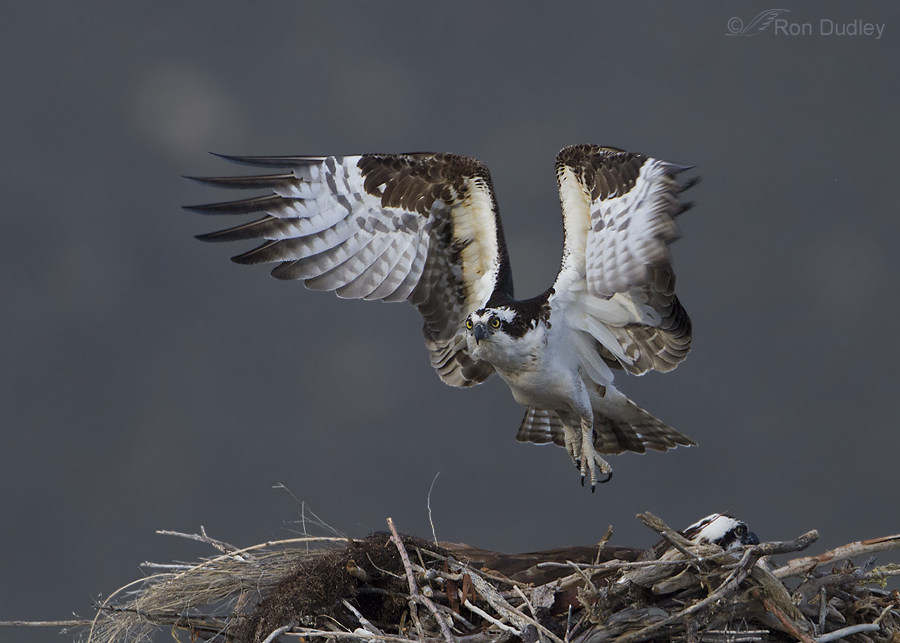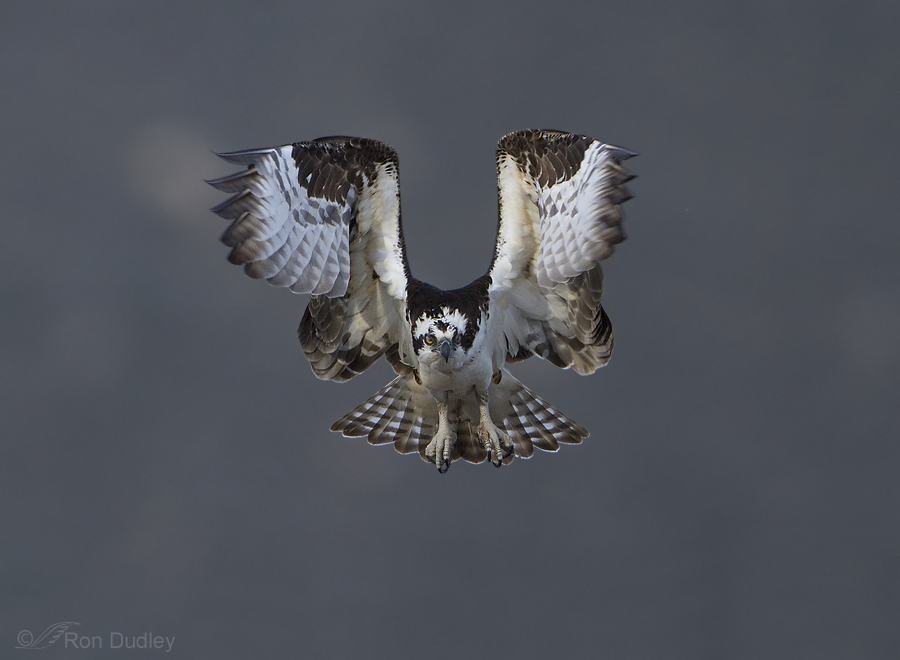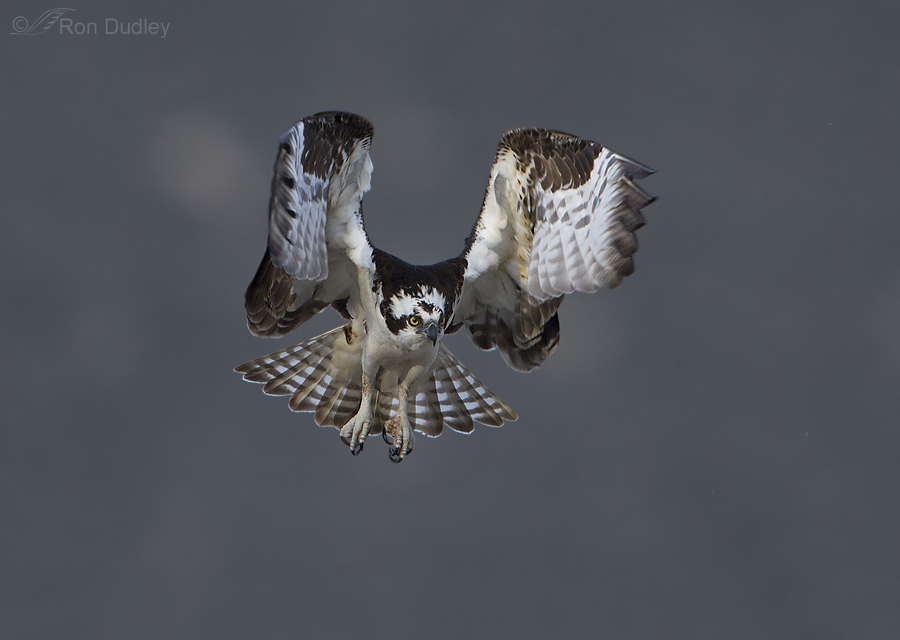This is the nesting pair of Ospreys I photographed at Flaming Gorge, Utah two weeks ago today. The male was coming in for a landing to relieve the female on the eggs.
1/1250, f/5.6, ISO 800, 500 f/4, 1.4 tc, natural light, not baited, set up or called in
Because of the low light I was deliberately underexposing the images as a means of getting a little more shutter speed for flight shots (to be adjusted for during processing). I’ve explained the rationale for that strategy in a previous Osprey post so I won’t go into it again here.
1/1250, f/5.6, ISO 800, 500 f/4, 1.4 tc, natural light, not baited, set up or called in
The dark background was a deeply shaded mountain to contrast the bird that had a little more light on it.
With this image and the next one I took the liberty of doing a little more processing than I prefer to do. In each of the two images there was just the top of the head of the female on the nest and a few twigs sticking up into the bottom of the frame so I cloned them out and added a narrow strip of canvas for composition.
1/1250, f/5.6, ISO 800, 500 f/4, 1.4 tc, natural light, not baited, set up or called in
In each of the first three images I liked the almost 3D effect provided by the checkerboard pattern in the whites of the primaries on the left wing. That effect disappears in the last shot with the wing fully extended.
1/1250, f/5.6, ISO 800, 500 f/4, 1.4 tc, natural light, not baited, set up or called in
Here I like how the wing of the male seems like it’s about to envelop the female, so near to her yet not touching her.
I’ll admit to some confusion about something in this sequence. The flight angle of the male in the first image seems different from the other three. It’s been long enough since I took the shots that I can’t remember exactly what happened here. Perhaps he changed his flight angle at the last second coming in or maybe the first shot is the first pass at the nest, then he came around again for the actual landing (which I doubt). But the images are presented in the order they happened (#0370, 0372, 0374, and 0377) and all three have a time stamp of 6:48 AM on 5/14/2013.
Maybe I’ve reached the point (age) where I should be taking notes in the field.
I sure hope not! There’s too much going on while I’m shooting as it is.
Ron






Wonderfully high-quality osprey pix. Amazing technique. Thank you. Was referred to your site from the osprey nest live cam at Audubon’s Hog Island, Maine —
http://whateverthelight.com/wildlife/birds/osprey/#comment-26
Nice shots Ron.
Osprey’s have been making a come-back here in Ohio. Volunteer groups have raised many Osprey platforms, and there are four at our local reservoir (three occupied).
Some of my shots here: http://whateverthelight.com/wildlife/birds/osprey/
Thanks, Bruce. I like what I see in the link you provided about efforts to encourage nesting of Ospreys in your area.
Ron, these shots simply take my breath away!
Charlotte
Thanks very much, Charlotte.
Superb series, Ron! The different angle might have been due to a shift in wind direction/speed as he attempted his landing. I see that often with Osprey approaching the nest. The nest locations are usually elevated enough they’re subject to different currents and “shear” than ground-level winds. Just a thought.
Love all of these immensely!
I think you may be right, Wally. Wish I could remember for sure.
Very interesting photos. I hear you about the note-taking. An idea for you: once you are through shooting, make a few notes while you still remember most of it. If what’s happening is important, it’s worth making notes at a convenient time. We definitely have to learn new coping skills as we get older, and I find making notes very helpful.
Thanks for the tip, Susan. I think the organizer I use for my photos includes an option for “notes”. I’ve never investigated it but now I think I will…
These are particularly interesting…he’s not taking off in the first shot, but not landing either…the configuration/foreshortening of the wings, especially his left, is so pronounced that if I painted it that way, I’d hear all kinds of criticism. The lighting is dramatic. Do you ever shoot in Big or Little Cottonwood?
Patty, I don’t often shoot in those canyons – too many vehicles and people most of the time. Since I generally shoot from my pickup all that hubbub is an issue.
Magnificent
Even with the male head on in the last shot I can see he has little “necklace”
And the underside of his primaries does remind me of a pattern in a quilt
Thanks
Thank you, Diana.
These are gorgeous shots of a gorgeous bird. I’ve been watching a nest near my home and twice I’ve seen the male come in for a landing, get really close to landing on the nest, then pull up and do a go around–like a student pilot doing touch and goes.
Thanks, Sharon. It’s possible that’s what happened here too.
These are excellent Ron! Love the clarity, sharpness and good contrast!!
We have two nests on the lake we are on, and Lake Champlain has several.
May I ask what you use for PP?
The only PP I use is Aperture. Been an Apple guy since they first came out, but as you know Aperture hasn’t come up with anything really new for its PP, thus I’m looking. I’ve read about Light Room, but I’m hesitant hoping that Aperture will come through?
Dick, I use Photoshop CS6 exclusively for processing. I know very little about those other processing programs.
Hi Dick.
I’ve been using LightRoom 4 for a few months now and like it a lot.
I rarely ever have to go back to Paint Shop Pro (my previous software) to do really heavy editing.
The best way to describe LightRoom is: It does less, better.
And it truly excels at organizing and exporting your images, providing a robust and customizable workflow (though the documentation is less than could be desired).
Feel free to contact me at my website if you have any questions about it.
Bruce
The 3D effect on those primaries reminds me of quilted material. Stunning shots. And that wing does indeed look ‘protective’ in your final shot. Thank you so much Ron.
Yes, you’re right, Elephant’s Child – that texture does look like “quilted material”.